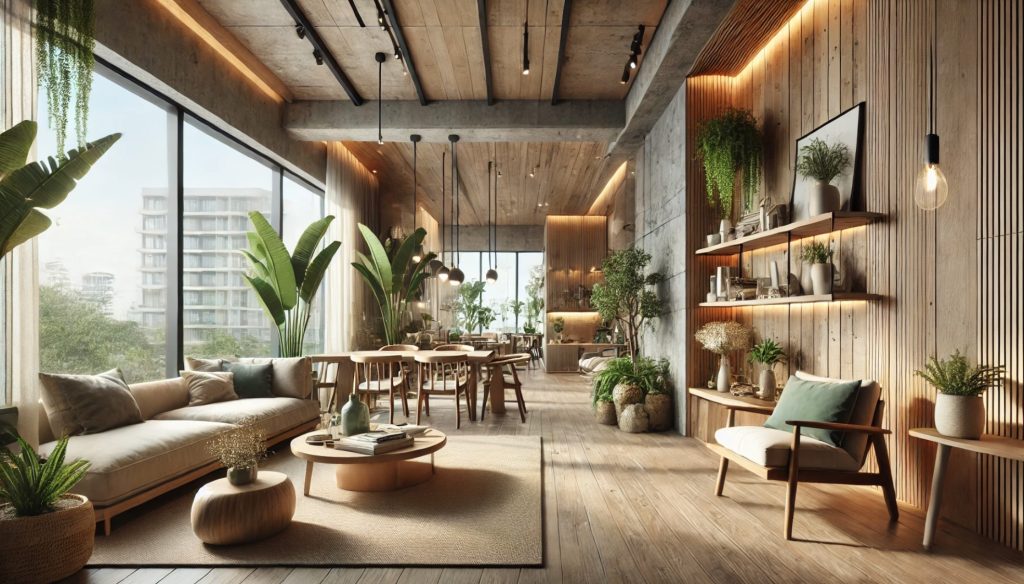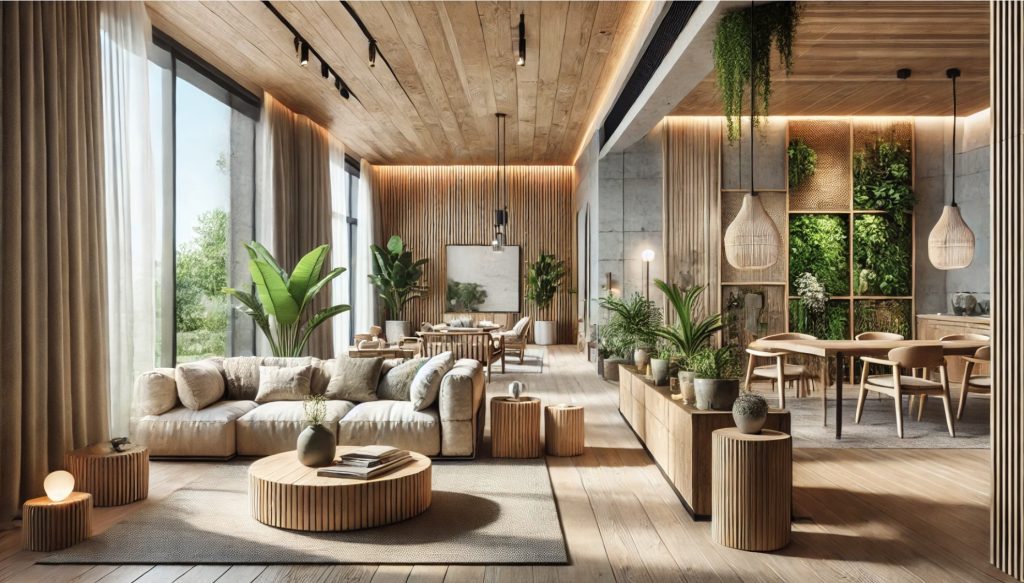
In today’s world, sustainability has become more than just a trend—it’s a necessity. With increasing awareness about environmental concerns, the demand for sustainable interior design is on the rise. Sustainable interior design is an innovative approach that focuses on creating spaces that are environmentally responsible and resource-efficient throughout their lifecycle. From material selection to energy-efficient lighting and furniture reuse, sustainable interior design incorporates numerous elements that help create eco-friendly spaces.
As more people and businesses recognize the value of reducing their carbon footprint, sustainable interior design has emerged as a key solution for those who want their spaces to reflect both aesthetics and environmental responsibility. In this article, we’ll explore how sustainable interior design can transform spaces into eco-friendly environments, the benefits of adopting this design approach, and how professionals like House De Arch lead the way in providing sustainable interior design services that prioritize both functionality and style.
What is Sustainable Interior Design?
Sustainable interior design is the process of designing spaces in a way that minimizes the negative impact on the environment. It involves choosing materials, products, and design practices that are resource-efficient, reduce waste, and promote environmental health. The goal of sustainable interior design is to create spaces that contribute to sustainability by reducing resource consumption, energy use, and pollution while promoting the well-being of the people who use the space.
Some of the core principles of sustainable interior design include:
- Sustainable material selection: Choosing materials that are renewable, recyclable, or reclaimed.
- Energy-efficient lighting and appliances: Using lighting and appliances that consume less energy.
- Waste reduction: Designing spaces in ways that minimize construction and operational waste.
- Indoor air quality: Choosing products that reduce indoor pollutants and improve air quality.
By incorporating these principles, sustainable interior design helps create spaces that are not only aesthetically pleasing but also kind to the environment.
Key Elements of Sustainable Interior Design
When it comes to sustainable interior design, there are several key elements that help create eco-friendly spaces. Here are some of the main components:
1. Sustainable Materials
The choice of materials is one of the most important factors in sustainable interior design. Using sustainable materials means opting for products that are renewable, recyclable, or reclaimed, as well as those that have a low environmental impact during their production process. Some examples of sustainable materials include:
- Bamboo: A fast-growing, renewable resource that is commonly used for flooring, furniture, and other interior elements.
- Recycled glass: Used in countertops, tiles, and other decorative features.
- Reclaimed wood: Sourced from old buildings, barns, or structures, and repurposed for use in new interiors.
- Cork: A renewable material that is harvested without harming the trees and is often used for flooring or wall coverings.
- Low-VOC paints and finishes: These products have fewer harmful chemicals that can contribute to indoor air pollution.
By selecting materials that are sustainably sourced, we can reduce the environmental impact of interior design projects.
2. Energy Efficiency
Energy efficiency is another important element of sustainable interior design. Designing spaces with energy efficiency in mind can significantly reduce the consumption of electricity and lower utility bills. Some of the ways energy efficiency is incorporated into sustainable design include:
- Energy-efficient lighting: LED lighting is a common choice for sustainable interiors because it uses significantly less energy than traditional lighting solutions.
- Natural lighting: Maximizing natural light through windows and skylights reduces the need for artificial lighting during the day.
- Energy-efficient appliances: Choosing appliances that have high energy efficiency ratings helps lower energy consumption and reduce greenhouse gas emissions.
3. Waste Reduction
One of the primary goals of sustainable interior design is to reduce the amount of waste generated during the design and construction process. This can be achieved by:
- Using recycled and recyclable materials: Selecting materials that can be reused or recycled at the end of their lifecycle helps reduce landfill waste.
- Minimizing construction waste: Sustainable design also involves carefully planning construction processes to minimize material waste.
- Designing for durability: By choosing materials and products that are built to last, we can reduce the need for frequent replacements, thus reducing waste.
4. Indoor Air Quality
Indoor air quality is a critical aspect of sustainable design because it directly affects the health and well-being of the occupants. Poor indoor air quality can result from the use of toxic materials, poor ventilation, and the accumulation of pollutants inside the space. Sustainable interior design helps improve indoor air quality by:
- Using low-VOC materials: Volatile organic compounds (VOCs) are harmful chemicals found in many paints, adhesives, and finishes. Low-VOC products help reduce indoor air pollution.
- Incorporating plants: Adding indoor plants helps purify the air by removing toxins and increasing oxygen levels.
- Improving ventilation: Proper ventilation helps reduce the buildup of indoor air pollutants and provides a steady flow of fresh air.

Benefits of Sustainable Interior Design
There are numerous benefits to adopting sustainable interior design practices. Here are some of the most notable advantages:
1. Environmental Benefits
One of the most obvious benefits of sustainable interior design is the positive impact it has on the environment. By using eco-friendly materials, reducing energy consumption, and minimizing waste, sustainable design helps conserve natural resources and reduce pollution. This, in turn, helps combat climate change and protects ecosystems.
2. Health Benefits
Sustainable interior design contributes to a healthier indoor environment by using materials that are free from harmful chemicals and promoting better air quality. This is particularly important in homes, offices, and public spaces where people spend significant amounts of time. Better indoor air quality can lead to improved respiratory health, reduced allergies, and an overall increase in well-being.
3. Economic Benefits
While sustainable interior design may require a higher initial investment in materials and energy-efficient systems, it often leads to long-term cost savings. For example, energy-efficient lighting and appliances can reduce energy bills, while durable, high-quality materials can minimize maintenance and replacement costs. Additionally, eco-friendly buildings and interiors tend to have higher property values, making sustainable design a smart financial choice.
4. Aesthetic Appeal
Contrary to the misconception that sustainable design is purely functional, many eco-friendly interiors are visually stunning. Designers can create beautiful, stylish spaces using sustainable materials like reclaimed wood, natural stone, and organic fabrics. The use of natural lighting, greenery, and minimalist design principles also adds to the aesthetic appeal of sustainable interiors.

Conclusion
Sustainable interior design offers an excellent way to create beautiful, functional, and eco-friendly spaces that have a positive impact on both people and the planet. By incorporating elements such as sustainable materials, energy efficiency, waste reduction, and improved indoor air quality, sustainable design helps minimize environmental impact while providing numerous benefits to the occupants.
At House De Arch, we specialize in sustainable interior design solutions that balance functionality with environmental responsibility. Our team of experts is dedicated to creating eco-friendly spaces that not only look great but also promote sustainability and well-being. If you’re ready to transform your space into an eco-friendly environment, contact House De Arch today to get started on your journey toward a sustainable future.

[…] Sustainability: Materials were carefully chosen to ensure minimal environmental impact, aligning with House De Arch’s philosophy of sustainable architecture. […]